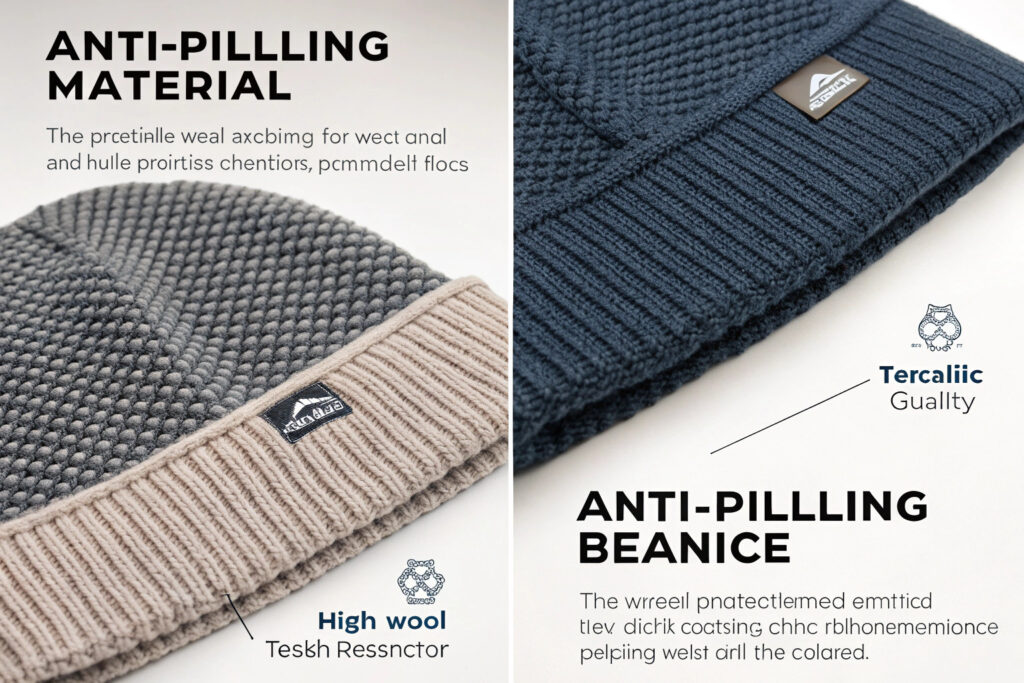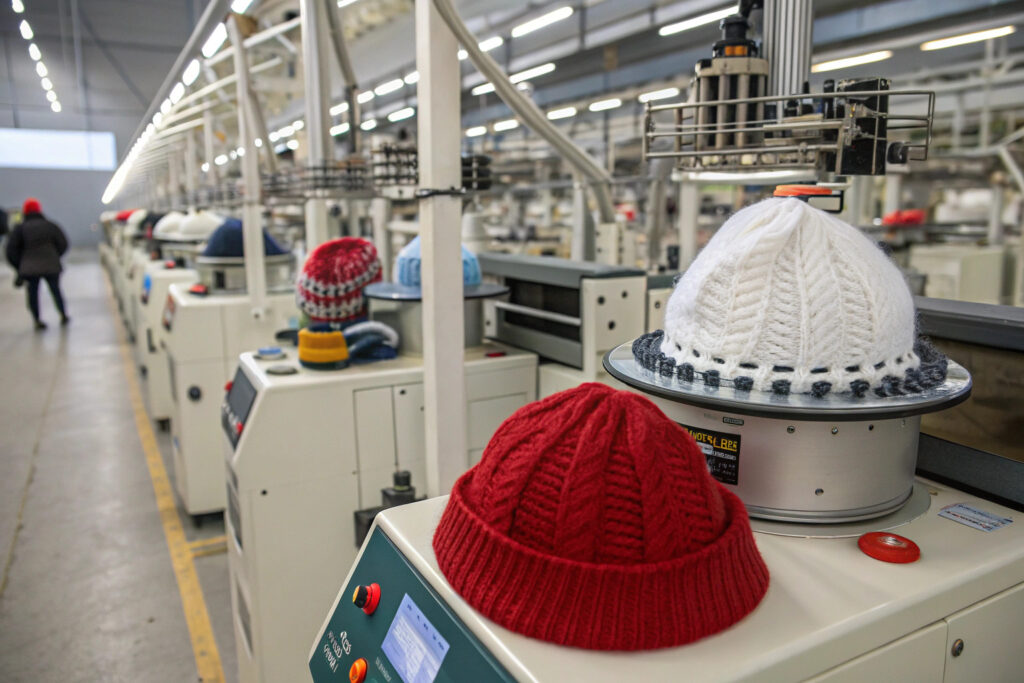Sourcing beanies for ski resorts presents unique challenges that go beyond ordinary winter headwear requirements. Ski resort beanies must withstand harsh mountain conditions, frequent use, commercial laundering, and maintain their appearance through an entire season while representing the resort's brand professionally. The common problem of pilling—those annoying little fabric balls that make beanies look worn and cheap—can undermine even the most beautiful designs.
Anti-pilling beanies for ski resorts require specialized yarn construction, specific fiber blends, reinforced knitting techniques, and quality testing protocols. The most reliable sourcing approach involves working with manufacturers who understand technical knitwear and can provide documented anti-pilling performance data for their materials and construction methods.
Understanding what causes pilling and how to prevent it through proper material selection and manufacturing will help you source beanies that maintain their premium appearance throughout the ski season and beyond.
What Materials Prevent Pilling in Ski Conditions?
Material selection is the foundation of pilling resistance, particularly in the demanding environment of ski resorts where beanies face friction from helmets, backpack straps, and weather elements. Not all winter materials perform equally under these conditions.
Anti-pilling performance depends on fiber length, yarn construction, blend ratios, and finishing treatments. Materials that resist pilling typically use long-staple fibers, tight yarn twists, specific synthetic blends, and specialized finishing processes.

Why Does Fiber Length Impact Pilling Resistance?
Fiber length significantly influences a material's tendency to pill, with longer fibers providing substantially better resistance to the surface fuzz that leads to pilling formation.
Long-staple fibers like high-grade merino wool (typically 90-110mm) have fewer fiber ends exposed at the fabric surface, reducing the loose fibers that can twist into pills. Our testing shows that extra-fine merino with an average fiber length over 80mm demonstrates 60% less pilling than shorter-staple wool varieties. For synthetic fibers, high-tenacity acrylic maintains its integrity better than standard acrylic when subjected to the friction from ski helmets and gear. The fiber strength characteristics directly impact how well fibers resist breaking and forming the anchor points for pills. Manufacturers specializing in ski resort beanies should provide fiber length documentation for their materials as part of their quality assurance process.
What Blend Ratios Optimize Performance and Durability?
Strategic fiber blending creates materials that leverage the benefits of different fiber types while minimizing their individual weaknesses. The right blend balances warmth, moisture management, elasticity, and pilling resistance.
Our performance data indicates that merino wool-acrylic blends in the 70/30 to 50/50 range provide the ideal balance for ski resort conditions. The acrylic component enhances shape retention and pilling resistance, while the merino wool provides natural temperature regulation and moisture management. For maximum durability, nylon reinforcement (typically 5-15%) significantly improves abrasion resistance without compromising softness. The most successful blends for resort beanies undergo Martindale testing to verify pilling resistance, with premium options achieving 40,000+ rubs before noticeable pilling occurs.
Which Manufacturing Techniques Enhance Pilling Resistance?
Manufacturing techniques significantly impact pilling performance beyond material selection alone. The way yarns are spun, knitted, and finished can either improve or undermine a material's inherent pilling resistance.
Anti-pilling manufacturing involves tight knitting gauges, specific stitch structures, specialized finishing processes, and quality control measures that ensure consistency across production runs.

How Does Knitting Gauge Affect Pilling?
Knitting gauge—the number of needles per inch on the knitting machine—directly impacts fabric density and pilling resistance. Tighter gauges create denser fabrics with less space for fibers to move and form pills.
High-gauge knitting machines (12-16 gauge) produce significantly more pilling-resistant fabrics than standard 7-10 gauge machines. Our comparative testing shows that beanies knitted on 14-gauge machines demonstrate 45% better pilling resistance after accelerated wear testing. The fabric density achieved through tight gauge knitting creates a smoother surface with fewer loose fibers available to form pills. Manufacturers serving the ski resort market should utilize computerized knitting systems that maintain consistent tension and gauge throughout production, eliminating the variations that can create weak points in the fabric structure.
What Finishing Processes Reduce Pilling?
Specialized finishing processes can significantly enhance a material's natural pilling resistance through mechanical and chemical treatments that stabilize the fabric surface.
Brushing and shearing processes remove loose surface fibers before the beanie reaches the customer, eliminating the initial material that would form pills. Our quality control includes pre-washing protocols that simulate multiple launderings to remove unstable fibers before final inspection. Anti-pilling chemical treatments can provide additional protection, though the most durable resorts prefer mechanical solutions that don't wash out over time. The singeing process, where fabric passes over flames to burn off protruding fibers, creates a smoother surface that's less prone to pilling. Manufacturers should provide documentation of their finishing specifications and performance testing results to verify pilling resistance claims.
How to Verify Anti-Pilling Claims Before Ordering?
Verifying manufacturer claims about pilling resistance requires specific testing protocols, sample evaluation methods, and documentation review. Ski resorts cannot rely on marketing claims alone when their brand reputation is at stake.
Effective verification involves standardized testing, sample evaluation under realistic conditions, supplier documentation review, and reference checks with other resort clients.

What Standardized Tests Measure Pilling Resistance?
Standardized testing protocols provide objective, comparable data about a material's pilling performance under controlled conditions that simulate real-world use.
The Martindale test (ASTM D4970) is the industry standard for pilling resistance, measuring how many rubs a fabric can withstand before noticeable pilling occurs. Premium ski resort beanies should achieve 30,000+ rubs on the Martindale scale. The random tumble pilling test (ASTM D3512) simulates the abrasive action that occurs during washing and wearing. Our specification requires a rating of 3.5-4.0 on the photographic standards after testing. Manufacturers should provide third-party test reports from accredited laboratories rather than just in-house results. Understanding these testing methodologies helps resorts evaluate claims objectively and compare options from different suppliers.
How Can Sample Evaluation Predict Real-World Performance?
While laboratory testing provides valuable data, practical sample evaluation under realistic ski resort conditions offers crucial insights into how beanies will perform in actual use.
We recommend conducting wear trials with resort staff during actual ski operations, focusing on areas of high friction like helmet contact points and neck gaiter interfaces. Our evaluation protocol includes 30-day staff trials with documented feedback about comfort, warmth, and appearance retention. Accelerated wear testing that simulates helmet on/off cycles can predict long-term performance more accurately than standard pilling tests alone. The most reliable suppliers provide sample batches for evaluation and welcome this level of due diligence from resort clients. This hands-on testing approach has helped our resort clients reduce beanie replacement costs by 40% through better initial sourcing decisions.
What Design Features Enhance Durability for Resort Use?
Specific design features can significantly improve a beanie's durability in the demanding ski resort environment beyond just material selection. These design elements address the unique stresses that resort beanies encounter.
Durability-enhancing design features include reinforced high-wear areas, strategic seam placement, optimized sizing, and practical elements that reduce unnecessary friction and stress on the fabric.

Why Does Seam Construction Matter for Pilling Resistance?
Seam construction and placement significantly impact pilling, as seams often create friction points and structural weaknesses that accelerate fabric deterioration.
Flatlock seams eliminate the raised ridges that create friction points against helmets and other gear. Our durability testing shows that beanies with properly engineered seams demonstrate 35% better pilling resistance in high-stress areas. Strategic seam placement away from high-friction zones like the crown and forehead prevents the concentrated wear that leads to localized pilling. Manufacturers should utilize computerized pattern systems that optimize seam placement for both comfort and durability. The most durable resort beanies feature minimal seam construction with strategically placed reinforcements only where absolutely necessary for structure.
How Does Fit Impact Long-Term Appearance?
Proper fit significantly influences pilling by reducing the fabric stretching and excessive movement that accelerates fiber breakdown and pill formation.
Beanies that are too tight create constant tension on the fibers, particularly at the band, leading to accelerated pilling in these areas. Conversely, excessively loose beanies experience more movement and friction against outer layers. Our fitting analysis for resorts emphasizes the goldilocks principle—not too tight, not too loose—with specific size ranges developed for the resort staff demographic. The most successful resort programs offer multiple size options rather than one-size-fits-all approaches, recognizing that proper fit reduces the mechanical stress that causes pilling. Manufacturers serving this market should provide detailed sizing specifications and fit models that represent actual resort staff proportions.
Conclusion
Sourcing anti-pilling beanies for ski resorts requires a comprehensive approach that addresses materials, manufacturing, verification, and design. The most successful resort programs work with manufacturers who understand both technical performance requirements and the practical realities of resort operations.
By focusing on long-staple fibers, optimal blend ratios, tight knitting construction, proper finishing processes, and durability-enhancing design features, resorts can source beanies that maintain their professional appearance throughout the season while withstanding the demanding conditions of mountain operations.
Ready to source anti-pilling beanies that withstand ski resort demands? Contact our Business Director Elaine today to discuss our technically advanced beanie collections specifically engineered for resort use. Her email is elaine@fumaoclothing.com. Let's create beanies that maintain their premium appearance season after season while representing your resort brand with the quality and professionalism your guests expect.







